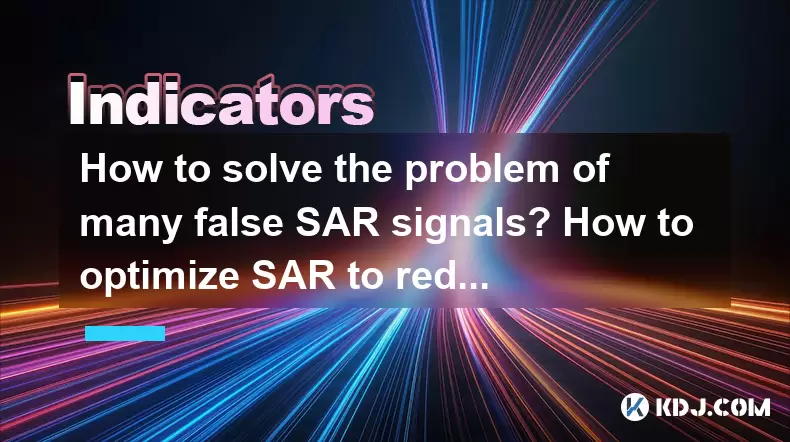-
 bitcoin
bitcoin $114779.865156 USD
2.30% -
 ethereum
ethereum $4226.519789 USD
2.39% -
 tether
tether $1.000545 USD
0.04% -
 xrp
xrp $2.890223 USD
0.92% -
 bnb
bnb $1030.029301 USD
2.95% -
 solana
solana $212.824944 USD
1.69% -
 usd-coin
usd-coin $0.999757 USD
0.01% -
 dogecoin
dogecoin $0.234961 USD
-0.27% -
 tron
tron $0.337174 USD
0.42% -
 cardano
cardano $0.804783 USD
0.09% -
 hyperliquid
hyperliquid $45.748770 USD
-2.85% -
 chainlink
chainlink $21.699170 USD
0.82% -
 ethena-usde
ethena-usde $1.001452 USD
0.08% -
 avalanche
avalanche $30.237800 USD
1.14% -
 stellar
stellar $0.372604 USD
1.52%
How to solve the problem of many false SAR signals? How to optimize SAR to reduce error prompts?
The Parabolic SAR indicator is useful for crypto traders but often gives false signals; optimizing parameters and using other indicators can help mitigate these issues.
May 22, 2025 at 12:01 pm

The Parabolic Stop and Reverse (SAR) indicator is a popular tool among cryptocurrency traders for determining potential reversals in price trends. However, many traders face the challenge of false SAR signals, which can lead to premature entries and exits, ultimately affecting their trading performance. This article will explore strategies to identify and mitigate these false signals, as well as methods to optimize the SAR indicator to reduce error prompts.
Understanding False SAR Signals
False SAR signals occur when the indicator suggests a trend reversal that does not materialize. This can happen due to market noise, sudden price spikes, or other short-term fluctuations that do not represent a genuine change in the trend direction. Identifying these false signals is crucial for maintaining a robust trading strategy.
To distinguish between a true and a false signal, traders should consider the broader market context. For instance, if the SAR indicator suggests a reversal but the overall trend, as indicated by moving averages or trend lines, remains unchanged, it is likely a false signal. Additionally, correlating the SAR signals with other technical indicators such as the Relative Strength Index (RSI) or Moving Average Convergence Divergence (MACD) can provide a more comprehensive view of the market, helping to filter out false signals.
Optimizing SAR Parameters
The standard settings of the SAR indicator, with an acceleration factor of 0.02 and a maximum value of 0.2, may not be suitable for all market conditions, particularly in the volatile cryptocurrency market. Adjusting these parameters can help reduce the frequency of false signals.
- Lowering the acceleration factor can make the SAR indicator less sensitive to price movements, potentially reducing the number of false signals. For instance, setting the acceleration factor to 0.01 instead of 0.02 can result in fewer reversals being indicated.
- Increasing the maximum value can allow the indicator to continue following the trend for a longer period before reversing. A higher maximum value, such as 0.3, can help in maintaining the trend direction during minor price fluctuations.
Experimenting with different combinations of these parameters on historical data can help traders find the optimal settings for their specific trading strategy and the cryptocurrency pair they are trading.
Using SAR in Conjunction with Other Indicators
To further optimize the SAR indicator and reduce false signals, traders can combine it with other technical indicators. Using multiple indicators can provide a more robust signal and help confirm the validity of the SAR's indications.
- Moving Averages: A common strategy is to use the SAR in conjunction with a moving average. If the SAR suggests a reversal, but the price remains above or below the moving average, it could indicate a false signal.
- RSI and MACD: These momentum indicators can help confirm whether the market is overbought or oversold, providing additional context to the SAR's signals. For example, if the SAR indicates a bearish reversal but the RSI shows the market is still oversold, it might be a false signal.
- Volume Indicators: High trading volume can confirm the strength of a trend. If the SAR indicates a reversal but the volume does not support it, the signal might be false.
By integrating these indicators, traders can create a more comprehensive trading system that is less susceptible to false signals.
Implementing a Confirmation Period
Another effective strategy to reduce false SAR signals is to implement a confirmation period. This involves waiting for a certain number of candles or a specific time period after the SAR indicator suggests a reversal before taking action.
- Setting a Confirmation Period: For instance, if the SAR indicates a bullish reversal, traders might wait for the next three candles to confirm the upward movement before entering a long position. This waiting period can help filter out short-term price fluctuations that might lead to false signals.
- Using Price Action: During the confirmation period, traders can look for additional price action signals, such as a breakout from a consolidation pattern or a retest of a support or resistance level, to further validate the SAR's indication.
Implementing a confirmation period requires patience but can significantly enhance the reliability of the SAR indicator.
Backtesting and Continuous Monitoring
Backtesting the SAR indicator with the optimized parameters and confirmation strategies is essential to validate their effectiveness. Traders should use historical data to simulate trades and assess the performance of their strategy. This process can help identify any remaining issues with false signals and refine the approach further.
Continuous monitoring of the strategy's performance in live trading is equally important. Market conditions can change, and what works today might not work tomorrow. Regularly reviewing and adjusting the SAR settings and confirmation strategies based on current market dynamics can help maintain the strategy's effectiveness over time.
Frequently Asked Questions
Q: Can the SAR indicator be used effectively in highly volatile cryptocurrency markets?A: Yes, the SAR indicator can be used effectively in volatile markets, but it requires careful optimization and the use of additional confirmation tools. Adjusting the acceleration factor and maximum value, as well as combining the SAR with other indicators like moving averages and RSI, can help manage the increased volatility and reduce false signals.
Q: How often should I adjust the SAR parameters?A: The frequency of adjusting SAR parameters depends on the market conditions and the performance of your trading strategy. It is recommended to review and potentially adjust the parameters monthly or after significant market changes to ensure they remain effective.
Q: Is it possible to automate the process of filtering false SAR signals?A: Yes, it is possible to automate the process of filtering false SAR signals using algorithmic trading platforms. By programming the platform to incorporate the strategies discussed, such as using multiple indicators and confirmation periods, traders can automate the decision-making process and reduce the impact of false signals.
Q: What are the risks of relying solely on the SAR indicator for trading decisions?A: Relying solely on the SAR indicator can lead to increased exposure to false signals, particularly in volatile markets. The indicator should be used in conjunction with other technical analysis tools and fundamental analysis to create a well-rounded trading strategy that can better handle the complexities of the cryptocurrency market.
Disclaimer:info@kdj.com
The information provided is not trading advice. kdj.com does not assume any responsibility for any investments made based on the information provided in this article. Cryptocurrencies are highly volatile and it is highly recommended that you invest with caution after thorough research!
If you believe that the content used on this website infringes your copyright, please contact us immediately (info@kdj.com) and we will delete it promptly.
- AI Training's Energy Crisis: Can Decentralization with Greg Osuri Offer a Solution?
- 2025-09-30 20:45:14
- Crypto Presales: Unlocking Potential 'Buy Now' for 'Presale Gains'
- 2025-09-30 21:05:15
- Prenetics, Danny Yeung, and Token 2049: A Bold Bitcoin Strategy
- 2025-09-30 20:45:14
- Bitcoin Investment in 2025: Navigating the Crypto Landscape
- 2025-09-30 20:50:11
- Pi Network Price Prediction & Crypto News: Navigating the Hype in a Utility-Driven Market
- 2025-09-30 21:05:15
- Dogecoin, Pepe Coin, and Remittix: Meme Mania Meets Utility in the Crypto Wild West
- 2025-09-30 20:50:11
Related knowledge

What is a tower bottom candlestick pattern? Does it have a high success rate?
Sep 22,2025 at 07:18am
Tower Bottom Candlestick Pattern Explained1. The tower bottom candlestick pattern is a reversal formation that typically appears at the end of a downt...

What is a black hole pattern in the MACD indicator? Is it a cause for concern?
Sep 21,2025 at 06:54pm
Bitcoin's Role in Decentralized Finance1. Bitcoin remains the cornerstone of decentralized finance, serving as a benchmark for value and security acro...

How can I use the psychological line (PSY) to determine market sentiment?
Sep 17,2025 at 02:19pm
Understanding the Psychological Line (PSY) in Cryptocurrency TradingThe Psychological Line, commonly referred to as PSY, is a momentum oscillator used...

How can I determine if a double top pattern has officially formed?
Sep 21,2025 at 03:18am
Understanding the Structure of a Double Top Pattern1. A double top pattern consists of two distinct peaks that reach approximately the same price leve...

What is the Golden Valley pattern on the moving average? Is it better than the Silver Valley pattern?
Sep 21,2025 at 02:54pm
Understanding the Golden Valley Pattern in Moving Averages1. The Golden Valley pattern is a technical formation observed in cryptocurrency price chart...

What does a death cross of the RSI in the strong zone (above 50) mean?
Sep 17,2025 at 10:54pm
Understanding the Death Cross in RSI Context1. The term 'death cross' is traditionally associated with moving averages, where a short-term average cro...

What is a tower bottom candlestick pattern? Does it have a high success rate?
Sep 22,2025 at 07:18am
Tower Bottom Candlestick Pattern Explained1. The tower bottom candlestick pattern is a reversal formation that typically appears at the end of a downt...

What is a black hole pattern in the MACD indicator? Is it a cause for concern?
Sep 21,2025 at 06:54pm
Bitcoin's Role in Decentralized Finance1. Bitcoin remains the cornerstone of decentralized finance, serving as a benchmark for value and security acro...

How can I use the psychological line (PSY) to determine market sentiment?
Sep 17,2025 at 02:19pm
Understanding the Psychological Line (PSY) in Cryptocurrency TradingThe Psychological Line, commonly referred to as PSY, is a momentum oscillator used...

How can I determine if a double top pattern has officially formed?
Sep 21,2025 at 03:18am
Understanding the Structure of a Double Top Pattern1. A double top pattern consists of two distinct peaks that reach approximately the same price leve...

What is the Golden Valley pattern on the moving average? Is it better than the Silver Valley pattern?
Sep 21,2025 at 02:54pm
Understanding the Golden Valley Pattern in Moving Averages1. The Golden Valley pattern is a technical formation observed in cryptocurrency price chart...

What does a death cross of the RSI in the strong zone (above 50) mean?
Sep 17,2025 at 10:54pm
Understanding the Death Cross in RSI Context1. The term 'death cross' is traditionally associated with moving averages, where a short-term average cro...
See all articles










































































